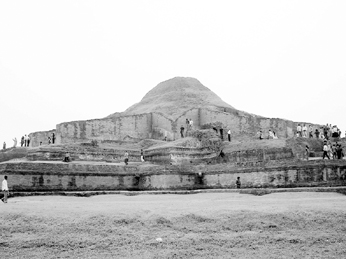
China can help boost BD tourism sector
Sarwar Md Saifullah Khaled | Saturday, 31 October 2015

By one account, against the global total of 6,000, Bangladesh is home to 500 Buddhist ancient monasteries and temples. Researchers in the tourism sector think if a small segment of the Buddhists, who account for around a third of world population including China, visit their religious heritage site in Paharpur that should yield a considerable amount of economic benefit for Bangladesh. Apart from this, Mahasthangarh and Mainamati are two other major sites of heritage of people of the Buddhist religious faith. However, the Buddhist world heritage lies in sheer neglect in the northern district of Naogaon, with its environs and access roads in not so good shape. An urgent facelift is an imperative to set the stage.
Current reports have it that China singly boasts the highest number of world's billionaires. Many of them have enough to live well and to spare for foreign travel. Large numbers of Chinese go abroad on holidaying vacation. If a fraction of its 1.5 billion strong population comes for such sightseeing in Bangladesh, Bangladesh's tourism industry would get a big boost. Western China, particularly its Yunnan Province, is close to Bangladesh. The planned "Silk Road" bus route through Bangladesh would build a bridge of road communications between China and Bangladesh. Besides, when built and completed, the international airport in the beach-city of Cox's Bazar could draw backpackers in large numbers from China and beyond.
This is no surprise. Tourism, be it religious, ecological, business or the like, has received little attention from the powers that are in Bangladesh. A few years back, when the former Prime Minister of China had visited Dhaka, Bangladesh was informally designated as the number one tourist destination for the Chinese. There has been no follow-up from Dhaka's part for cashing in on the gesture of Beijing. An avowedly socialist country, China has absorbed all the technological and monetary resources of the capitalist western world into its pragmatically devised 'one-country, two economies' system. World's most trading centres are awash now with "made in China" commodities. The spin-offs of capitalism are learnt to have made many men rich in the socialist country - China.
Besides, Bangladesh has so long been sitting unaware with several treasure-troves for tourism including a few unique ones in the world untapped. Two of the rarities of potential tourist interest are UN-recognized World Heritage Sites. The global legacies are the Sundarbans - the largest contiguous mangrove forest in the world - and world's biggest Buddhist monastery at Paharpur in Naogaon. The Cox's Bazar coast on the Bay of Bengal is also a unique one in that it is the longest unbroken sea beach in the world. The Bay, lying between South and Southeast Asia, is an important gateway that catches the imagination of all the big powers of the world: the United States, China, India, Australia and so on.
The year 2016 has been declared Tourism Year as part of the latest development recipe. A tourism master plan has been designed by the authority concerned. An international-standard airport in Cox's Bazar is seen as one of the keys to unlocking Bangladesh's tourism potential for the global public. The project is conceived. The main focus of the year-long tourism promotion is evidently religious tourism, based on the prospect of making the most of the world's largest monastery and a number of other sites in Bangladesh of anthropological-archaeological importance to the Buddhists of the world.
Moreover, little of the tourist interest in the bewitching flora and fauna of the Sundarbans has been harnessed. The panoramic vistas of rare trees, spotted deer and the world-famous Royal Bengal Tiger, aside streams fraught with fishes and crocodiles are worth seeing and attractive to both the indigenous and foreign tourists. The pre-Moghul-era Saat Gambuz Mosque in Bagherhat, in the vicinity of the Sundarbans, is also designated by the UNESCO as a heritage site. With the change of watchmen in the tourism ministry of Bangladesh, it appears that a little importance is being laid on development of tourism-related largest economic sector of the world with mobility of people getting supersonic speed - travelling across borders, seas, continents and even across the space.
However, a lot of classroom work has been done, even involving international agencies, on what is to be done for exploiting the potential of the tourism industry of Bangladesh. The World Tourism Organisation (WTO) prepared a strategic Tourism Master Plan with UNDP assistance in 1990 for Bangladesh. Establishing Exclusive Tourism Zones in the offshore islands was envisaged. Foreign direct investment for developing the sector was encouraged. Apart from developing the other facilities so far mentioned above, a prime need also is to develop the right infrastructural facilities including tourism products and ensure foolproof security in the tourist resorts and sites with sustained political stability in the country to attract foreign tourists; be it from China or elsewhere.
The writer is a retired Professor of Economics, BCS General Education Cadre. E-mail: smsaifullah_khaled@yahoo.com, sarwarmdskhaled@gmail.com